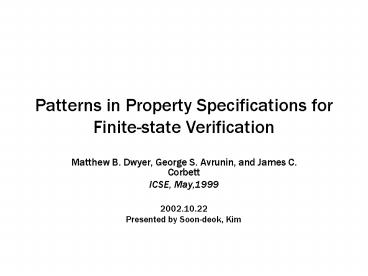Patterns in Property Specifications for Finitestate Verification - PowerPoint PPT Presentation
1 / 23
Title:
Patterns in Property Specifications for Finitestate Verification
Description:
Patterns in Property Specifications for Finite-state Verification ... of parameterizable, high-level, formalism-independent specification abstractions ... – PowerPoint PPT presentation
Number of Views:50
Avg rating:3.0/5.0
Title: Patterns in Property Specifications for Finitestate Verification
1
Patterns in Property Specifications for
Finite-state Verification
- Matthew B. Dwyer, George S. Avrunin, and James C.
Corbett - ICSE, May,1999
- 2002.10.22
- Presented by Soon-deok, Kim
2
Contents
- Introduction
- Specification pattern system
- Property Specification Patterns
- Pattern scopes
- Specification Patterns System
- The Patterns
- Organization
- Pattern Mapping
- Survey of property specifications
- Conclusions
- Further Work
3
Introduction(1/3)
- Formal specification and verification offer
practitioners some significant advantages - Transition of this technology from research to
practice has been slow - Practitioners are unfamiliar with specification
processes, notations, and strategies
4
Introduction(2/3)
- exgt Between the time an elevator is called at a
floor and the time it opens its doors at that
floor, the elevator can arrive at that floor at
most twice
(Transitions to at a floor-state occur at most 2
times) Between call and open
AG( call -gt !E!open U (!atfloor !open
EX(atfloor E!open U (!atfloor
!open EX(atfloor E!open
U (!atfloor !open EX(atfloor !open
EF(open))))))))
5
Introduction(3/3)
- Specification pattern system is
- a collection of parameterizable, high-level,
formalism-independent specification abstractions - This paper adopted a pattern-based approach to
presenting their specification abstractions - Focus on the matching of problem characteristics
to solution strategies - Would also be successful in the domain of
property specification for finite-state
verification
6
Property Specification Patterns(1/2)
- Generalized description of a commonly occurring
requirement on the permissible state/event
sequences in a finite-state model of a system - Describes the essential structure of some aspect
of a systems behavior - Provides expressions of systems behavior in a
range of common formalisms
7
Property Specification Patterns(2/2)
- 5 basic patterns
- Universal
- To be true throughout the execution
- Absence
- Never true in the execution
- Existence
- Is true at some point in the execution
- Precedence
- Designated state/event always occurs before first
occurrence of another designated state/event - Response
- Designated state/event is followed by another
designated state/event
8
Pattern Scopes(1/2)
- 5 basic scopes
- Global
- the entire program execution
- Before
- the execution up to a given state/event
- After
- the execution after a given state/event
- Between
- any part of the execution from one given
state/event to another given state/event - After-until
- like between but the designated part of the
execution continues even if the second
state/event does not occur
9
Pattern Scopes(2/2)
10
Specification Pattern System(1/8)
- A set of patterns
- Organized into one or more hierarchies with
connections between related patterns - Grow over time as developers encounter property
specifications of real systems that do not easily
map onto the existing patterns - Hypothesis
- only a small fraction of the possible properties
that can be specified commonly occur in practice
11
Specification pattern system(2/8)The
Patterns(1/2)
- Absence A given state/event does not occur
within a scope - Existence A given state/event must occur within
a scope - Bounded Existence A given state/event must
occur k times within a scope. - Universality A state/event occurs throughout a
scope - Precedence A state/event P must always be
preceded by a state/event Q within a scope. Fig1
gives the key elements of the pattern.
12
Specification pattern system(3/8)The
Patterns(2/2)
- Response A state/event P must always be
followed by a state/event Q within a scope - Chain Precedence -A sequence of states/events
P1,.. , Pn must always be preceded by a sequence
of states/events Q1,Qm. - Chain Response A sequence of states/events
P1,Pn must always be followed by a sequence of
states/events Q1,Qm.
13
Specification pattern system(4/8)Organization
- Organize the patterns in a hierarchy based on
their semantics
14
Specification pattern system(5/8) Patterns
Mapping(1/4)
- They provide mappings to
- Linear Temporal Logic (LTL)
- Computation Tree Logic (CTL)
- Quantified Regular Expressions (QREs)
- The Inca query language
- Graphical Interval Logic (GIL)
- Action Computation Tree Logic (ACTL)
- Regular Alternation-Free Mu-Calculus
- Tool accepting property specifications
- SPIN (accepts LTL)
- JavaPathFinder (accepts LTL)
- SMV (accepts CTL)
- FLAVERS (accepts QREs)
- CADP/EVALUATOR (accepts ACTL and Mu-Calculus)
15
Specification pattern system(6/8)Patterns
Mapping(2/4)
- Absence
- P is false
16
Specification pattern system(7/8)Patterns
Mappings(3/4)
- Response
- S response to P
(S response to P) between Q and R AG(Q !R -gt
A((P -gt A!R U (S !R)) AG(!R)) W R)
17
Specification pattern system(8/8)Patterns
Mappings(4/4)
- Bounded Existence
- Transitions to P-states occur at most 2 times
18
Survey of property Specifications(1/4)
- This paper assumed that the specifications people
write fall into a small number of categories - Empirical evidence for assumption
- Most fall into a small number of familiar
categories - Data Collection
- 555 specifications from at least 35 different
source - Wide variety of application domains
19
Survey of property Specifications(2/4)
- Total for Patterns/Scopes
20
Survey of property Specifications(3/4)
- Total Number of Instances for Patterns/Scopes
21
Survey of property Specifications(4/4)
- Percentage of Specifications for Each
Pattern/Scope
22
Conclusions
- Their proposed specification system provides a
set of commonly occurring high-level
specification abstractions for formalisms - Definition and use of high-level abstractions in
writing formal specifications - important factor in making automated formal
methods - Finite-state verification tools, more usable
- They have updated their pattern system to
accommodate new patterns and variations of
existing patterns in this survey
23
Further Work
- Defining a language for property specification
based on the patterns - Providing automated support for compiling
properties expressed in that language to specific
formalisms - Checking the legality of pattern substitutions
- Approaches for checking the consistency of
pattern mappings expressed in multiple formalisms































